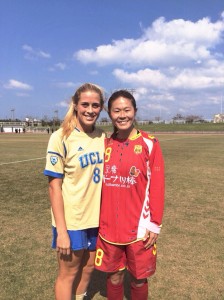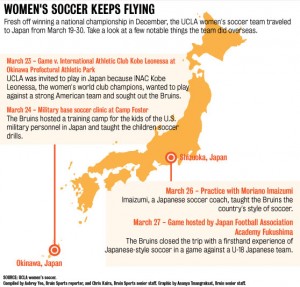After 14 hours in the air, the UCLA women’s soccer team could finally enjoy the familiar feeling of the earth beneath its feet once again. Only
this time, it was the feeling of Japanese soil.
And the first thing the Bruins did that March 21afternoon after being released from the confines of a chair within a China Airlines aircraft was practice – after all, they had a game to play against International Athletic Club Kobe Leonessa in just two days.
“(We were) shell-shocked. It was just like ‘OK, we’re here,’” said sophomore defender Belden Long. “But it was good to get the legs moving – after sitting so long, it felt good to breathe air.”

Junior midfielder and team captain Sarah Killion remembers the message from the coaching staff during winter break that began it all. It was simple, yet cryptic: “Don’t plan anything for spring break.”
INAC Kobe Leonessa, one of Japan’s top professional women’s soccer teams, kept the annual tradition of inviting an American team to scrimmage with for its preseason preparations.
It was time for 2014’s edition; the only problem was that none of the National Women’s Soccer League teams could make it. But Sky Blue FC’s coach Jim Gabarra had an idea for an alternative. He endorsed the next best thing – the NCAA national champions.
A couple of months later, that air of mystique had transformed into a concrete plan to tour Japan, and the team made the journey across thousands of miles to oblige.
But for soccer players brought up in the world of American-style soccer, where an athletic and physical style of play reigns supreme, the technique and finesse of Japanese soccer was an additional layer they needed to adjust to.
“The Japanese teams were way more skilled. They could hit a 40-yard ball, 50-yard ball; every ball was perfect on the dime,” said junior defender Caprice Dydasco. “Their movement was really good off the ball. … it’s different from college.”
The team had an initial dose of that brand of soccer on March 23. The resulting 3-2 defeat showed the disparity in level between one of the world’s best clubs and the best collegiate team in the United States, and just how much UCLA still had to learn.
A less technical breakdown of that gap between the Bruins and their Okinawan opponents could simply be explained with some numbers.
“We’ve only given up eight goals in 26 games, and giving up three goals in that one game is what (we) did differently – they punished us for our mistakes,” said coach Amanda Cromwell. “Other teams maybe didn’t punish us or we could make up for it with our athleticism and our speed, but the INAC team was too good; if we made a mistake, they were going to pounce on it, and they did it three times.”
But with every defeat comes the possibility to grow.
It served as a reminder that the team didn’t make its way across the globe just to soak in the experience of cherry blossoms and witness the splendor of Mount Fuji – it was also there to learn.
“The next training we had after we played INAC was super-intense, high-level training. It’s almost as if we were taking what we learned from the game on Sunday and putting it to use,” Cromwell said. “It was good to see that we actually benefited from that game just by how the level of training went up.”
A flight over to Shizuoka would give the team one more chance to incorporate what it just picked up into its repertoire. This time, however, the instructions were coming from someone who was better acquainted with the style of soccer – Japanese coach Morinao Imaizumi.
UCLA played its last game against Japan Football Association Academy Fukushima. It was a 2-1 win, but more than the score, it was a chance for every player on the team to get the minutes; it was a chance for each player to develop and bring that fresh take back to Westwood, ready for the year ahead.
“There’s no team like that INAC Kobe team that we could play in (Division l),” Cromwell said. “I wish we could play a team like that every week because they were so good, and they would stretch us and make us better. We learned a lot about ourselves.”
Unfortunately, the Bruins’ 10 days in Japan were finite.
After a short trip to Tokyo, it was time to bid farewell to foreign soil; home was just another 14-hour flight away.
